As an Amazon Associate I earn from qualifying purchases.
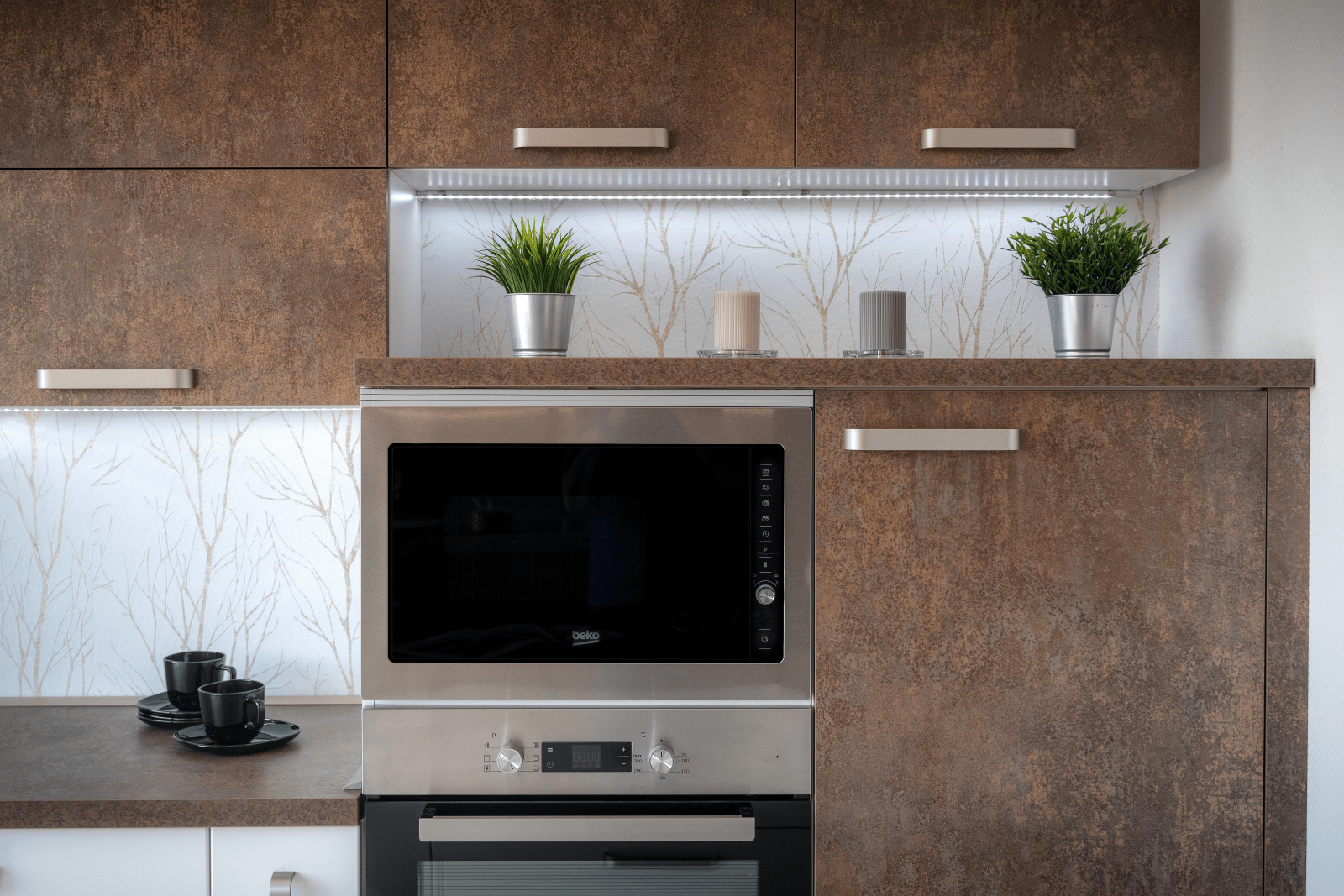
Microwaves and microwave ovens are often used interchangeably, but they are not exactly the same. Understanding the nuances between the two can help you make informed decisions when it comes to cooking and kitchen appliances. In this comprehensive guide, we’ll delve into the distinctions between microwave vs microwave oven, their functionalities, and their respective applications.
Microwaves, commonly known as microwave radiation, are a form of electromagnetic radiation with wavelengths ranging from about one meter to one millimeter. In the context of kitchen appliances, microwaves refer to the electromagnetic waves used in microwave ovens to cook or heat food.
How Microwave Ovens Work: A Detailed Explanation
Microwave ovens have revolutionized the way we cook, offering convenience and speed without compromising on taste. Understanding the inner workings of these appliances can deepen our appreciation for their efficiency and versatility. Since we’re on the topic of how a microwave compares vs a microwave oven, let’s talk about how microwave ovens work.
The Magnetron: The Heart of the Microwave Oven
At the core of every microwave oven lies a small but powerful device called the magnetron. This component is responsible for generating the microwaves that cook or heat food within the appliance. The magnetron converts electrical energy into electromagnetic radiation, specifically microwaves, through a process known as electron resonance.
Microwave Generation and Distribution
Once generated, the microwaves travel through a waveguide, a metal tube that directs the radiation into the cooking chamber. Within the chamber, the microwaves bounce off the reflective walls, ensuring even distribution of energy throughout the space. This uniform distribution is essential for consistent and thorough cooking.
Interaction with Food: The Role of Water Molecules
When food is placed inside the microwave oven and exposed to the microwaves, a fascinating interaction occurs between the radiation and the molecules within the food, particularly water molecules. Unlike traditional cooking methods that rely on conduction or convection to transfer heat, microwave cooking operates on a principle known as dielectric heating.
Dielectric Heating: A Unique Cooking Method
In dielectric heating, the electric field of the microwaves causes polar molecules, such as water molecules, to rapidly oscillate. This oscillation generates heat within the food, effectively cooking it from the inside out. Because microwaves penetrate the food, rather than just heating the surface, microwave cooking can be significantly faster than conventional methods.
Efficiency and Speed: Advantages of Microwave Cooking
One of the primary advantages of microwave cooking is its efficiency and speed. When considering microwave vs microwave oven, the latter can heat food almost instantaneously, unlike conventional ovens that rely on preheating and long cooking times. This rapid heating not only saves time but also reduces energy consumption, making microwave ovens more environmentally friendly than their conventional counterparts.
Safety Considerations: Preventing Uneven Heating
While microwave cooking offers many benefits, it’s essential to take certain precautions to ensure food safety and quality. Uneven heating can be a concern in microwave ovens, as some areas of the food may absorb more microwaves than others. To prevent this, it’s crucial to stir or rotate the food periodically during the cooking process, promoting more uniform heating.
The Role of Microwave-Safe Containers
Choosing the right cookware is also essential for successful microwave cooking. Microwave-safe containers are designed to withstand the intense heat and energy of microwaves without warping, melting, or releasing harmful chemicals into the food. Look for containers labelled as microwave-safe or specifically designed for microwave use to ensure optimal results.
Microwave ovens harness the power of microwaves to cook or heat food quickly, efficiently, and safely. The magnetron, waveguide, and reflective walls work in harmony to generate and distribute microwaves evenly throughout the cooking chamber. By understanding the principles of dielectric heating and taking appropriate safety precautions, users can unlock the full potential of their microwave ovens, enjoying delicious meals with minimal time and effort.
Key Differences Between Microwaves and Microwave Ovens
Below we’ve outlined some of the key differences between a microwave vs microwave oven
- Functionality: Microwaves are a form of electromagnetic radiation, whereas microwave ovens are appliances that utilize microwaves to cook or heat food. While microwaves are a natural phenomenon, microwave ovens are human-made devices designed for culinary purposes.
- Design and Construction: Microwaves are electromagnetic waves that travel through space, whereas microwave ovens are physical appliances typically found in kitchens. Microwave ovens consist of a metal box with a control panel, cooking chamber, and a magnetron to generate microwaves.
- Usage: Microwaves have various applications beyond cooking, including telecommunications and radar systems. Microwave ovens, however, are specifically designed for cooking and heating food quickly and efficiently.
FAQs: Microwave vs Microwave Oven – What’s the Real Difference?
Is there a difference between a microwave and a microwave oven?
Yes, but it depends on how the terms are used. A microwave typically refers to the appliance that heats food using microwave radiation. A microwave oven is the full name for the same device, though some people use “oven” to describe convection models that can bake or roast.
Do microwave ovens cook differently than standard microwaves?
Some do. A basic microwave heats food by exciting water molecules, which cooks from the inside out. A microwave oven with convection adds a fan and heating element, allowing for baking and crisping, making it more versatile than a standard microwave.
Can a microwave oven replace a regular oven?
A convection microwave oven can handle some baking and roasting tasks, but it won’t fully replace a traditional oven. While it speeds up cooking, it has a smaller interior and may not provide the same browning or crisping results as a full-sized conventional oven.
Is a microwave oven safer than a standard microwave?
Both are equally safe when used correctly. They operate using the same microwave technology. However, a convection microwave oven may require more caution because it uses a heating element that gets hot, unlike a standard microwave that only heats the food.
Why do some people call it a microwave while others say microwave oven?
“Microwave” is simply a shortened version of “microwave oven.” In everyday conversation, most people drop “oven” unless they’re specifically talking about a model that includes convection cooking. It’s a bit like calling a refrigerator a “fridge”—just an easier way to say it!
Can you bake in a microwave vs microwave oven?
In a regular microwave, baking is nearly impossible because it only heats food through moisture molecules. A microwave oven with convection can bake small cakes, cookies, or pizzas because it has an added heating element that mimics a traditional oven.
Exploring the Diverse Applications of Microwaves
Microwaves, a form of electromagnetic radiation, find a myriad of applications across various fields, from telecommunications to medicine. Understanding the versatility of microwaves can shed light on their importance in modern technology and everyday life.
Telecommunications: Connecting the World
Microwaves play a crucial role in telecommunications, facilitating wireless communication over long distances. Satellite communication systems utilize microwaves to transmit data, voice, and video signals between ground stations and orbiting satellites, enabling global connectivity. Additionally, microwave towers and antennas are used in terrestrial microwave communication networks to relay signals between communication hubs, such as cell towers and data centers.
Radar Systems: Navigating the Skies
Radar systems rely on microwaves to detect and track objects in the air, on land, and at sea. Microwave radar technology is used in air traffic control systems to monitor aircraft movements, weather surveillance radars to track storms and precipitation, and maritime radars to navigate ships and detect hazards. The ability of microwaves to penetrate through fog, clouds, and other atmospheric conditions makes them invaluable for remote sensing and surveillance applications.
Astronomy: Exploring the Cosmos
In astronomy, microwaves provide valuable insights into the universe’s structure, composition, and evolution. Radio telescopes equipped with microwave detectors observe celestial objects and phenomena that emit microwaves, such as galaxies, stars, and cosmic microwave background radiation. By studying microwave emissions from distant galaxies and cosmic phenomena, astronomers can unravel mysteries about the origins of the universe and the formation of galaxies and stars.
Medicine: Healing and Diagnosis
Microwaves have applications in medicine, particularly in therapeutic treatments and diagnostic imaging. Microwave ablation is a minimally invasive medical procedure used to treat certain types of cancer by delivering focused microwave energy to target tumors, destroying them while sparing surrounding healthy tissue. In diagnostic imaging, microwave technology is utilized in techniques such as microwave radiometry and microwave-induced thermoacoustic imaging to detect abnormalities in tissues and organs with high sensitivity and resolution.
Materials Processing: Enhancing Efficiency
Microwaves are employed in materials processing industries to enhance efficiency and precision in various manufacturing processes. In the food industry, microwave heating is used for cooking, drying, and pasteurizing food products, reducing processing times and preserving nutritional quality. In the semiconductor industry, microwave plasma-enhanced chemical vapor deposition (PECVD) is utilized to deposit thin films of materials onto semiconductor substrates, enabling the fabrication of advanced electronic devices with high performance and reliability. When considering microwave vs microwave oven, it’s important to recognize the diverse applications of microwaves beyond just household cooking, highlighting their critical role in both food processing and semiconductor manufacturing.
Environmental Monitoring: Protecting the Planet
Microwaves contribute to environmental monitoring and research efforts aimed at understanding and mitigating the impacts of climate change and natural disasters. Microwave remote sensing satellites measure parameters such as soil moisture, vegetation density, and ocean surface temperature, providing valuable data for climate modeling, agriculture, and disaster management. Additionally, microwave sensors on spacecraft monitor polar ice caps, glaciers, and sea ice extent, helping scientists track changes in Earth’s cryosphere and assess the effects of global warming.
Best Microwave Ovens: Top Picks in 2024
Microwaves have become indispensable kitchen appliances, offering convenience and efficiency in meal preparation. With a wide range of options available on the market, it’s essential to understand the features, pros, and cons of different models to make an informed decision. In this comprehensive guide, we’ll delve into the specifics of five popular microwave ovens, highlighting their key features, advantages, and drawbacks. Let’s take some time, since we’re on the topic of how microwaves differ vs microwave ovens, to review the best some of the best microwaves.
Farberware Countertop Microwave 1000 Watts, 1.1 cu ft
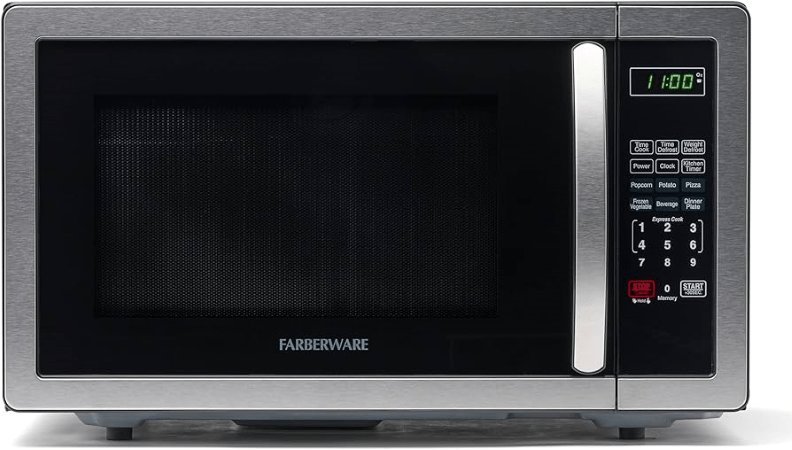
Key Features
- 1000 watts of cooking power
- 1.1 cubic feet capacity
- 10 power levels for customized cooking
- Six pre-programmed cooking functions
- Digital control panel with LED display
- Multi-stage cooking capability
- Removable rotating glass turntable
- Child safety lock feature
| PROS | CONS |
|---|---|
| Powerful cooking performance | Relatively large footprint may not be suitable for small kitchens |
| Spacious interior capacity | Limited color options available |
| Versatile cooking options with pre-programmed functions | |
| Easy-to-use digital control panel | |
| Even heating with multi-stage cooking | |
| Convenient safety lock feature for households with children |
BLACK+DECKER Digital Microwave Oven 0.9 Cu Ft
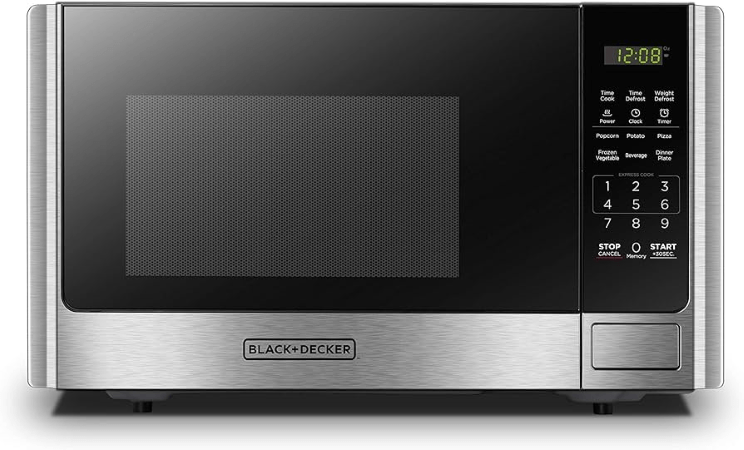
Key Features
- 900 watts of cooking power
- 0.9 cubic feet capacity
- Ten power levels for precise cooking control
- Digital control panel with LED display
- Six pre-programmed cooking functions
- Express cooking option for quick heating
- Interior light for easy monitoring
- Child safety lock feature
Pros and Cons
| PROS | CONS |
|---|---|
| Compact design ideal for small kitchens or dorm rooms | Lower cooking power compared to higher wattage models |
| Efficient cooking performance with multiple power levels | Smaller interior capacity may not accommodate larger dishes |
| Easy-to-read digital display and intuitive control panel | |
| Quick heating with express cooking option | |
| Interior light enhances visibility during cooking | |
| Safety lock feature for peace of mind |
Comfee EM720CPL-PMB Countertop Microwave Oven 0.7 Cu Ft
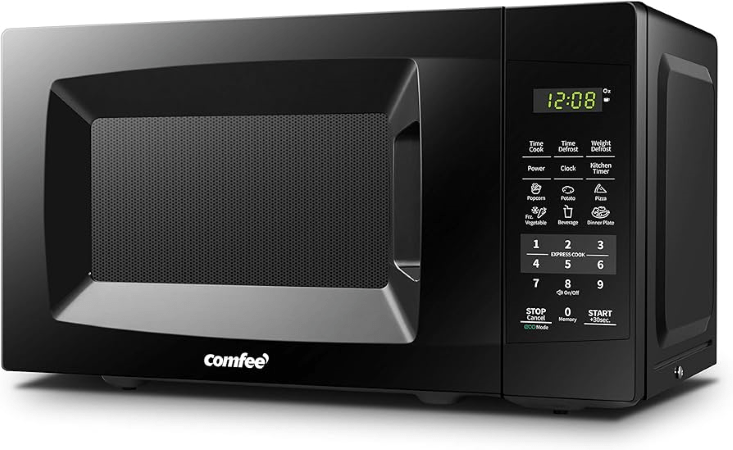
Key Features
- 700 watts of cooking power
- 0.7 cubic feet capacity
- Eleven power levels for precise cooking control
- Compact design suitable for small spaces
- One-touch cooking presets for popular dishes
- Energy-saving eco mode
- Easy-to-read digital control panel
- Turntable with removable glass tray
Pros and Cons
| PROS | CONS |
|---|---|
| Space-saving design perfect for apartments or RVs | Lower cooking power may result in longer cooking times |
| Multiple power levels for versatile cooking options | Limited interior space may not accommodate larger dishes |
| Quick and convenient cooking with one-touch presets | |
| Energy-efficient operation with eco mode | |
| User-friendly digital control panel | |
| Removable glass tray for easy cleaning |
TOSHIBA EM131A5C-SS Countertop Microwave Oven 1.2 Cu Ft
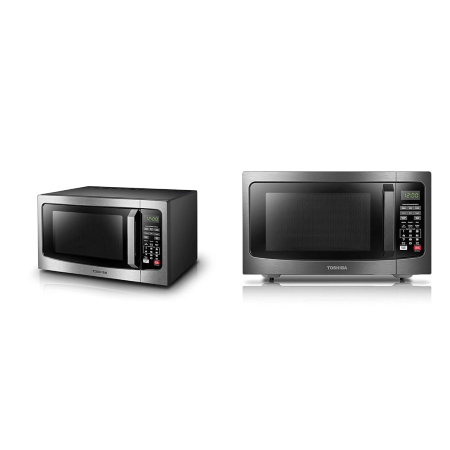
Key Features
- 1100 watts of cooking power
- 1.2 cubic feet capacity
- Ten power levels for precise cooking control
- Sensor cooking and reheating functions
- Easy-to-read digital control panel with LED display
- One-touch popcorn button
- Interior light and glass turntable
- Energy-saving eco mode
Pros and Cons
| PROS | CONS |
|---|---|
| High cooking power for fast and efficient heating | Relatively large size may not be suitable for compact kitchens |
| Spacious interior capacity accommodates large dishes | Limited color options available |
| Sensor cooking technology ensures optimal results | |
| Intuitive control panel with convenient presets | |
| Quick and easy popcorn preparation with one-touch button | |
| Energy-saving mode reduces power consumption |
Panasonic Microwave Oven NN-SN686S 1.2 Cu Ft, 1200W
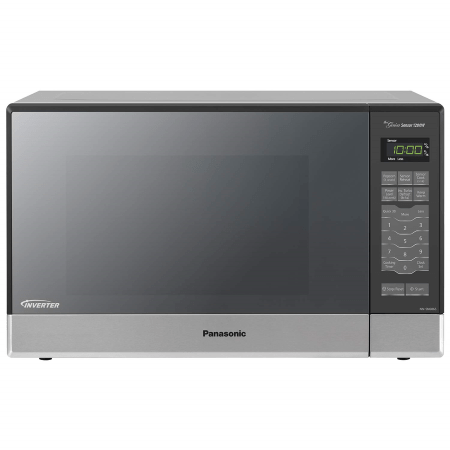
Key Features
- 1200 watts of cooking power
- 1.2 cubic feet capacity
- Inverter technology for consistent cooking results
- 14 preset menu items for easy cooking
- Turbo defrost feature for rapid thawing
- One-touch genius sensor cook and reheat
- Sleek stainless steel exterior
- Child safety lock feature
Pros and Cons
| PROS | |
|---|---|
| High cooking power for fast and efficient cooking | Higher price point compared to other models |
| Inverter technology ensures even heating and consistent results | Stainless steel exterior may require frequent cleaning to maintain appearance |
| Wide range of preset menu items for convenient cooking | |
| Turbo defrost feature accelerates thawing process | |
| Genius sensor cook and reheat for automatic cooking adjustments | |
| Stylish stainless steel design adds a modern touch to any kitchen |
Conclusion: Making the Right Choice
In conclusion, each of these five microwaves offers unique features and benefits suited to different user needs and preferences. Whether you prioritize cooking power, interior capacity, compact design, or advanced technology, there’s a microwave on this list to suit your requirements. By considering the key features, pros, and cons of each model, you can make an informed decision and select the perfect microwave for your kitchen.
Advantages of Microwave Ovens

Microwave ovens have become a staple in modern kitchens, offering convenience, efficiency, and versatility in meal preparation. From reheating leftovers to cooking elaborate dishes, these appliances have revolutionized the way we approach cooking. In this comprehensive guide, we’ll explore the myriad advantages of microwave ovens and why they are a valuable addition to any kitchen. We’ll also examine the common terminology, such as microwave vs microwave oven, to clarify any confusion and help you better understand these indispensable appliances.
Speed and Efficiency: Cooking in a Flash
One of the most significant advantages of microwave ovens is their unparalleled speed and efficiency. Unlike conventional ovens that require preheating and extended cooking times, microwave ovens can heat food in a matter of minutes, sometimes even seconds. This rapid cooking process is ideal for busy individuals or families with hectic schedules, allowing them to enjoy freshly cooked meals without the long wait.
Preservation of Nutrients: Retaining Food Quality
Another key benefit of microwave ovens is their ability to preserve the nutritional content of food. Traditional cooking methods, such as boiling or frying, can lead to nutrient loss due to prolonged exposure to heat and water. In contrast, microwave cooking minimizes nutrient loss by heating food quickly and efficiently, preserving vitamins, minerals, and antioxidants. This makes microwave ovens an excellent choice for health-conscious individuals who want to maintain the nutritional integrity of their meals.
Energy Efficiency: Saving Time and Resources
Microwave ovens are also more energy-efficient than conventional ovens, helping users save both time and resources. Because microwave ovens cook food faster and require less preheating time, they consume less energy overall. This not only reduces utility bills but also minimizes the environmental impact associated with cooking. By choosing microwave ovens over traditional cooking methods, users can contribute to energy conservation efforts while enjoying the convenience of quick and efficient meal preparation.
Versatility in Cooking: From Simple to Gourmet
One of the most appealing aspects of microwave ovens is their versatility in cooking. Whether you’re reheating leftovers, defrosting frozen ingredients, or cooking elaborate dishes from scratch, microwave ovens can handle a wide range of culinary tasks with ease. From steaming vegetables to baking potatoes to roasting meats, the possibilities are virtually endless. This flexibility makes microwave ovens a valuable tool for both novice cooks and seasoned chefs alike, allowing them to experiment with new recipes and techniques with confidence.
Convenience and Ease of Use: Cooking Made Simple
Perhaps the most underrated advantage of microwave ovens is their convenience and ease of use. Unlike traditional cooking methods that require constant monitoring and precise temperature control, microwave ovens are incredibly user-friendly. With simple controls and intuitive settings, even inexperienced cooks can achieve delicious results with minimal effort. Whether you’re a busy professional, a college student, or a parent juggling multiple responsibilities, microwave ovens make meal preparation a breeze, allowing you to enjoy homemade meals without the hassle.
Space-Saving Design: Perfect for Small Kitchens
In addition to their functional benefits, microwave ovens also offer a space-saving design that is perfect for small kitchens or limited countertop space. Unlike bulky conventional ovens that take up valuable real estate, microwave ovens are compact and lightweight, making them easy to incorporate into any kitchen layout. Whether you live in a cramped apartment or a cozy studio, a microwave oven can provide all the cooking power you need without sacrificing precious space.
In conclusion, microwave ovens offer a multitude of advantages that make them indispensable in today’s fast-paced world. From their unmatched speed and efficiency to their ability to preserve nutrients and energy, these appliances are a game-changer in the kitchen. With their versatility, convenience, and space-saving design, microwave ovens empower users to cook with confidence and creativity, turning everyday meals into culinary delights. Whether you’re a busy professional, a health-conscious individual, or a culinary enthusiast, a microwave oven is sure to enhance your cooking experience and simplify your life.
Disadvantages of Microwave Ovens
While microwave ovens offer unparalleled convenience and speed in the kitchen, they also come with a set of drawbacks that users should be aware of. Understanding the limitations of these appliances can help individuals make informed decisions about their use. In this detailed guide, we’ll delve into the disadvantages of microwave ovens and how they may impact your cooking experience. Additionally, we’ll address the common terminology debate of microwave vs microwave oven to provide clarity and enhance your understanding of these kitchen appliances.
Uneven Heating: The Challenge of Consistency
One of the primary disadvantages of microwave ovens is their tendency to heat food unevenly. Unlike conventional ovens that rely on convection currents to distribute heat evenly, microwave ovens can sometimes result in hot spots and cold spots within the food. This uneven heating can lead to undercooked or overcooked areas, compromising the overall quality and taste of the dish.
Limited Cooking Options: Constraints on Culinary Creativity
While microwave ovens are versatile appliances, they have certain limitations when it comes to cooking options. Some cooking techniques, such as baking or browning, are challenging to achieve in a microwave oven due to the lack of direct heat. Additionally, certain types of food, such as bread or pastries, may not turn out as well in a microwave oven compared to a conventional oven. This can restrict the range of recipes that can be prepared using a microwave oven, limiting culinary creativity.
Texture and Flavor Alteration: Sacrificing Taste for Convenience
Another disadvantage of microwave ovens is their potential to alter the texture and flavor of certain foods. While microwave cooking is quick and convenient, it may not always produce the same results as traditional cooking methods. Foods cooked in a microwave oven may lack the crispy exterior or caramelization that is achieved through baking, grilling, or frying. Additionally, the intense heat generated by microwaves can sometimes cause food to become rubbery or soggy, detracting from its overall appeal.
Health Concerns: Questioning Nutritional Integrity
There are also health concerns associated with the use of microwave ovens, particularly regarding the nutritional integrity of the food. While microwave cooking is generally considered safe, some studies suggest that it may lead to nutrient loss in certain foods, particularly vegetables. The rapid heating process can break down vitamins and minerals, reducing their nutritional value.
Additionally, there are concerns about the potential formation of harmful compounds, such as carcinogens, during microwave cooking, although more research is needed to fully understand the risks. When considering the debate of microwave vs microwave oven, it’s important to be aware of these potential health implications to make informed choices about your cooking methods.
Safety Hazards: Risks of Improper Use
Improper use of microwave ovens can pose safety hazards to users and the surrounding environment. When considering microwave vs microwave oven usage, one common concern is the use of inappropriate containers or cookware, such as metal or aluminum foil, which can cause arcing or sparking and potentially damage the appliance.
Additionally, microwave ovens can generate intense heat, leading to the risk of burns or scalds if precautions are not taken when handling hot dishes. It’s essential to follow the manufacturer’s guidelines and exercise caution when using microwave ovens to avoid accidents.
Environmental Impact: Considering Energy Consumption
While microwave ovens are generally more energy-efficient than conventional ovens, they still contribute to energy consumption and environmental impact. The production and disposal of microwave ovens can have significant environmental consequences, including the use of non-renewable resources and the generation of electronic waste.
Additionally, the energy used to power microwave ovens, although minimal compared to other appliances, still adds to overall household energy consumption. Users should be mindful of their energy usage and consider eco-friendly alternatives when possible.
In conclusion, while microwave ovens offer numerous advantages in terms of convenience and efficiency, they also have several disadvantages that users should be mindful of. From uneven heating and limited cooking options to concerns about texture, flavor, and nutritional integrity, there are various factors to consider when using microwave ovens.
By understanding the drawbacks and taking appropriate precautions, users can maximize the benefits of microwave cooking while minimizing potential risks. Whether you’re reheating leftovers or preparing a quick meal on the go, being aware of the limitations of microwave ovens can help you make informed choices about your cooking habits.
Amazon and the Amazon logo are trademarks of Amazon.com, Inc, or its affiliates.